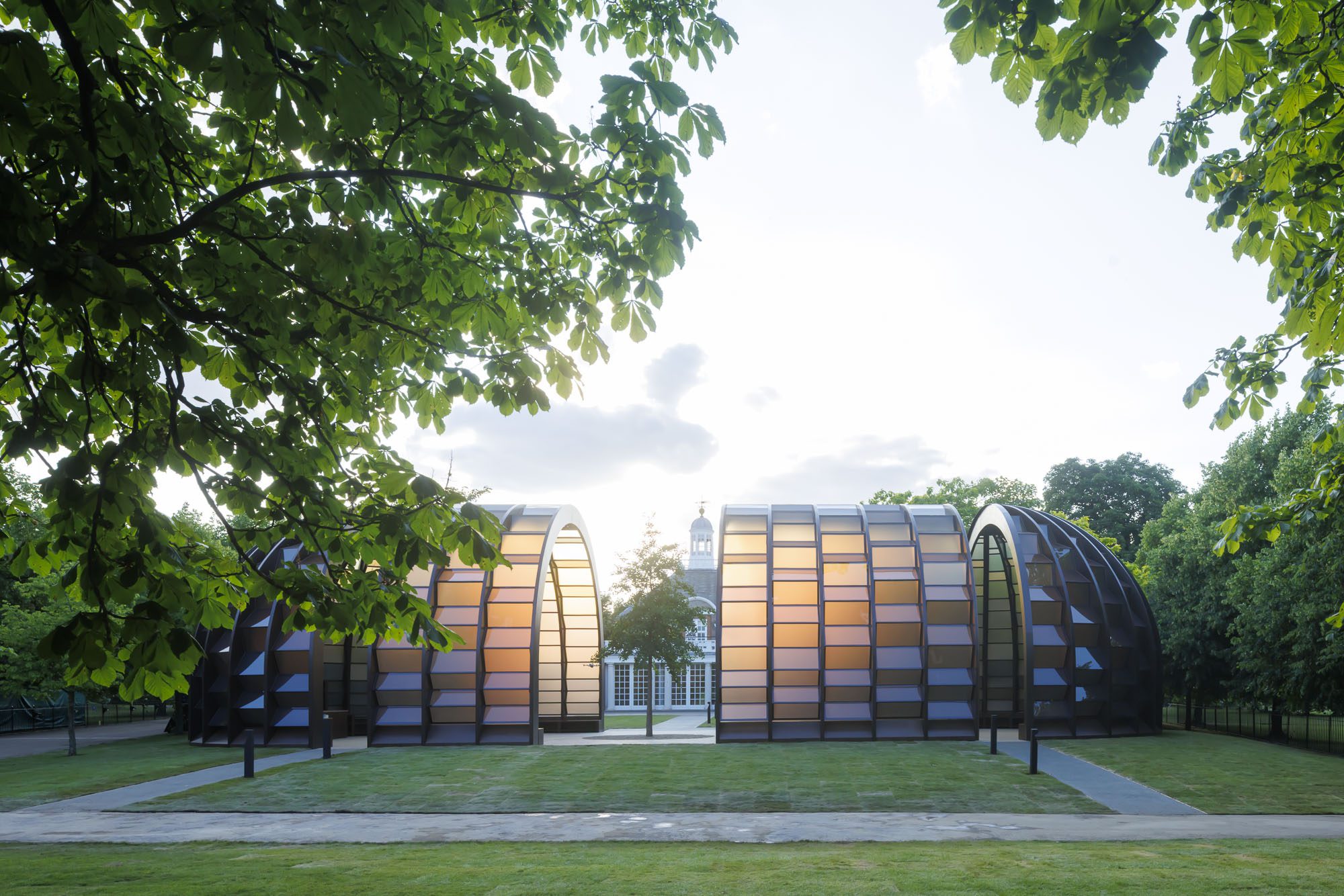The Serpentine Pavilion 2025, A Capsule in Time, designed by Bangladeshi architect and educator Marina Tabassum and her firm, Marina Tabassum Architects (MTA), opened on June 6, 2025 with Goldman Sachs supporting the annual project for the 11th consecutive year. Tabassum’s Pavilion marks the 25th year of this pioneering commission and continues Dame Zaha Hadid’s ethos of pushing the boundaries of architecture. Her mantra – ‘There should be no end to experimentation’ – is the foundation in which this commission is built upon, and Tabassum’s Pavilion exemplifies this.
Celebrated for her work that seeks to establish an architectural language that is contemporary while rooted and engaging with place, climate, context, culture and history, Tabassum’s design will resonate with Serpentine South and aims to prompt a dialogue between the permanent and the ephemeral nature of the commission. The 2025 Pavilion is elongated in the north-south direction and features a central court that aligns with Serpentine South’s bell tower. Inspired by the tradition of park-going and arched garden canopies that filter soft daylight through green foliage, the sculptural quality of the Pavilion is comprised of four wooden capsule forms with a translucent façade that diffuses and dapples light when infiltrating the space.
Marking the first structure by Tabassum to be built entirely from wood, it also employs light as a way to enhance the qualities of the space. Emphasizing the sensory and spiritual possibilities of architecture through scale, geometry and the interplay of light and shadow, Tabassum’s design also features a kinetic element where one of the capsule forms is able to move and connect, transforming the Pavilion into a new spatial configuration. According to the architect, the pavilion offers a place where people of diverse backgrounds, ages, and cultures can come together under one roof and call for action, facilitating dialogues that expand our boundaries of tolerance and respect
“The Serpentine Pavilion celebrates the London summer – a time to be outdoors, connecting with friends and family in Kensington Gardens. We want to celebrate the tradition of park-going. On a sunny day, the play of filtered daylight through the translucent façade draws on the memory of being under a Shamiyana at a Bengali wedding. Built from a bamboo structure wrapped with colorfully decorated cloth, Shamiyanas can convene hundreds of guests on any occasion. The Serpentine Pavilion offers a unique platform under the summer to unite as people rich in diversity,” said Marina Tabassum, Architect, Marina Tabassum Architects (MTA).
Built around a semi-mature Ginkgo tree – a climate resilient tree species that dates back to the early Jurassic Period – Tabassum’s Pavilion, like much of Tabassum’s previous projects, considers the threshold between inside and outside, the tactility of material, lightness and darkness, height and volume. Throughout the course of summer and into autumn, the Gingko tree leaves will slowly shift from green to luminous gold-yellow. The selection of a Gingko was inspired by the fact this species is showing tolerance to climate change and contributes to a diverse treescape in Kensington Gardens. The species is not susceptible to many current pest and diseases, and will be replanted into the park following the Pavilion’s closure in October.
The Pavilion is formed by a half capsule with two vaulted canopies and two semi-domes separated by pathways and a courtyard. The archaic volume of the half capsule, generated by geometry and wrapped in light material, draws upon the paradoxical relationship of permanence and impermanence. The ethereal quality of daylight coming through this semi-transparent façade creates a cheerful, yet pensive atmosphere. According to the architects, a tree at the center of the courtyard symbolizes our primordial connection to nature.
“We’re thrilled that Marina Tabassum’s design for the 25th Anniversary Serpentine Pavilion reflects the legacy of past commissions and responds to the Serpentine’s unique location in Kensington Gardens. The kinetic element of A Capsule in Time echoes the levitating features of Rem Koolhaas & Cecil Balmond with Arup’s 2006 Pavilion, and the gingko tree at its center roots the structure to the Earth and to Tabassum’s vision for evolved human connections with the environment. We are deeply grateful to all our loyal partners whose generosity will once again make an incredible idea for the Serpentine Pavilion into a reality, to be enjoyed by audiences all summer as the hub of the Serpentine’s public programme,” said Bettina Korek, Chief Executive and Hans Ulrich Obrist, Artistic Director.
In an era of increasing censorship, Tabassum expands on her desire for the Pavilion to function as a versatile space where visitors can come together and connect through conversations and sharing of knowledge. Tabassum and her team at MTA have compiled a selection of books that celebrate the richness of Bengali culture, literature, poetry, ecology and Bangladesh. Stored on shelves built into the structure, it draws on the Pavilion’s afterlife once no longer sited on Serpentine’s lawn, which is envisioned as a library open to all. All of the materials used in the Pavilion have been sourced locally and specified to keep reusability in mind.
“For 25 years, the Serpentine Pavilion has been a highlight of the capital’s cultural calendar, inspiring Londoners and visitors every summer. This year Marina Tabassum’s A Capsule In Time has created a space for visitors to come together, share ideas and connect through their love of art. It’s a great example of the power of creativity and how London celebrates the very best international talent, as we build a better, more prosperous London for everyone,” concluded Justine Simons, OBE, Deputy Mayor for the Culture and the Creative Industries.
